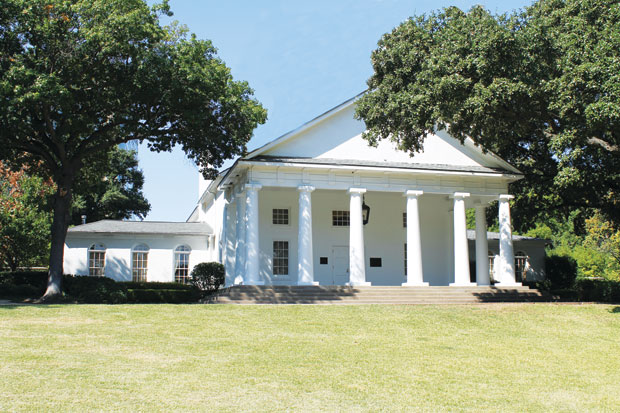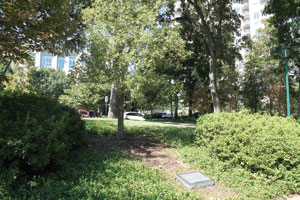Conservation efforts pay off for historic Lee Park fixture

the house that lee built | Arlington Hall at Lee Park celebrates its 75th anniversary. (David Taffet/Dallas Voice)
These days, it’s easy to miss the stately Arlington Hall, situated in the heart of the usually tranquil Lee Park. Skyscrapers overshadow the 17-acre park off Turtle Creek Boulevard.
The honks and hums of vehicles barreling down the surrounding streets and the noise of bustling city life remind visitors, should they find the park, that they’re in the heart of a big and busy city.
On Friday, Oct. 24, the Lee Park & Arlington Hall Conservancy, which oversees the campus, celebrates the community center’s 75th anniversary with a lunch and lecture by Gary
Scott, the former director of the federal parks service.
Arlington Hall has been witness to Dallas — and American — history. At 75, the hall has seen the neighborhood gentrify and transform. It saw the birth of the Alan Ross Texas
Freedom Parade and activists in the 1960s protesting the Vietnam War. It has survived the widening of Turtle Creek Boulevard. It has also been re-built after falling into disrepair.
Before 1939, however, Arlington Hall was only a field house.
Dallas architect Mark Lemmon designed the building, a two-thirds scale replica of Arlington House, Robert E. Lee’s home in Arlington, Va. Dedicated in 1939, efforts to honor the legacy of Robert E. Lee were spearheaded by the Dallas Southern Memorial Association, which had devoted itself to the park over the decades.
According to the Pocket Guide to Arlington Hall and Lee Park, the DSMA has been at the heart of efforts to preserve Arlington Hall and Lee Park. Formed in 1922 to “to preserve the culture, history, traditions and spirit of the South and to give gifts and service to the community,” the Dallas chapter is now one of the few remaining Southern Memorial Association chapters in the country.
In 1928, the group proposed a large bronze equestrian statue of Lee. And in 1936, after eight years of fundraising, the DSMA commissioned sculptor A. Phimister Proctor. Before the statue’s dedication, the Dallas parks board re-named the park to Lee Park in time for the statue’s dedication by President Franklin D. Roosevelt, who opened the Texas Centennial Exposition at Fair Park the same day.
The bronze statue featured Lee on his horse Traveller, accompanied by the mounted figure of a young man representing the youth of the South who fought with General Lee.
During World War II, Arlington Hall hosted as many American Red Cross and USO events as high school proms, debutante events and weddings. But the site has also been a hotbed of activism, sometimes a source of contention among the park’s various stakeholders.
In the late 1980s, when Dallas Tavern Guild Executive Director Alan Ross wanted to erect an AIDS memorial in Lee Park, he faced considerable pushback. The campus had already been a site for the Dallas Gay Pride Organization in 1983, which has since become the Alan Ross Texas Freedom Parade.
According to Voice archives, Ross faced a number of roadblocks — not just from the DSMA, but from city officials, too: “The DSMA argued to the council that Lee Park was not a neighborhood park but a tribute to Robert E. Lee. The Turtle Creek Association said the park would not be suitable for children [if it included an AIDS memorial]. Park board members said they didn’t want to dedicate public land to one specific disease and suggested the memorial be placed at Parkland hospital, the Dallas Morning News reported.
They said they didn’t like the precedent the memorial set.”
Finally in July 1990, the park board ruled that the Tavern Guild could erect an AIDS memorial but couldn’t use the words “AIDS,” “gay” or “lesbian.”
But there was one thing that the various stakeholders — including at that point the city of Dallas, the DSMA, the Turtle Creek Association and Dallas Tavern Guild — couldn’t deny: The facility was aging and in need of repair.
After conversations with the city, the Lee Park & Arlington Hall Conservancy public-private partnership formed. In 1998, the conservancy was officially authorized by the city to manage the campus through a bond package and numerous private donations.
A capital campaign launched in 2002 expanded and revitalized the hall. A generous gift from philanthropist Margaret Hunt Hill paid for the addition of a porte-cochere that gave the building a more genteel, southern feel.
The campus grounds, once overgrown and deteriorating, are flourishing, now, and a generous gift from Bobbie Snyder recently allowed the conservancy to build a winding bridge, promenade and viewing deck connecting the park with the city’s flourishing bike trails.
Still nestled in the park is the small but poignant AIDS memorial dedicated to Alan Ross, the man who fought to have it installed in the park: “This living tribute and surrounding beautification project is a gift to Lee Park and the city of Dallas in recognition of the AIDS community of Dallas County,” the plaque reads. Like the park itself, it’s a reminder of the progress and triumphs of Dallas history.
………………….
Oct. 24:
Program and luncheon at Arlington Hall, featuring Gary Scott, director emeritus of the National Park Service, 11:30 a.m. $75, reservations required.
Oct. 26:
Open House at Arlington Hall,
1:30-4:30 p.m. Refreshments and tours.
Free and open to the public.
Dec. 1:
Conservancy Members and
Patrons Party, 6-10 p.m.
Dec. 1:
Light Up Lee Park, 5:30-8 p.m., lights, music, hot chocolate and fireworks
show in Lee Park. Free and open to the public.
Visit LeeParkConservancy.org or Robert E. Lee Park on Facebook for more information.
This article appeared in the Dallas Voice print edition October 24, 2014.


